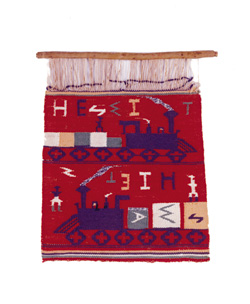 All they meant to do was vacation in Arizona. Until the moment a patch of red in a wall hanging caught Don Korb’s eye, he and his wife, Jean, had simply planned on a little rest at a resort north of Phoenix in the winter of 1990.
All they meant to do was vacation in Arizona. Until the moment a patch of red in a wall hanging caught Don Korb’s eye, he and his wife, Jean, had simply planned on a little rest at a resort north of Phoenix in the winter of 1990.
That little patch of red turned the trip into the first step of an odyssey that not only took them back again and again to Arizona, but alerted their senses to the beautiful patterns and designs woven by Native American women, and their minds to the United States history written in every movement of the looms. That one patch of red also turned Don Korb ’45, a retired business executive from Evansville, Indiana, into a collector.
Korb currently owns 85 American Indian weavings. He’s bought four more since he lent them last year to the Eiteljorg Museum in Indianapolis, but now he swears he has stopped buying. Jean insists, he says. She said they couldn’t move around in their house because the Indian weavings were all over the place. They talk in a loving, teasing way about the weavings, as if they were just so much clutter, but Korb has amassed a collection that is at once museum-worthy and a beautiful history lesson.
 | |
|
|
About 130 years later, U.S. Army troops surrounded the Navajo tribe and imprisoned them in Ft. Sumner, New Mexico. With all their natural supplies stripped away, the Navajos stopped weaving—a fact brought quickly to the attention of the military command when there were no new blankets for their horses. Worse, the Indian women were in danger of losing their weaving skills for lack of practice. The government ordered yarn from Germantown, Pennsylvania, with a man-made vivid red added to the fibers.
To the Navajo, red represented the East, the source of the greatest spiritual power in the universe. They used the red strands to create beautiful designs in their own clothes, and in the saddle blankets, rugs, and wall hangings that soon spread throughout the country, purchased by tourists for their homes.
Don Korb has collected 85 of these weavings through his trips to the Southwest. Eventually he plans to give some of them to his three daughters, a few to a museum in Evansville, and the remainder to the Eiteljorg Museum.
Yet there is magic in those weavings for him still.
"The reds just leap out when the sun shines on them," he says. "And when they leap, I’m smitten and I buy."